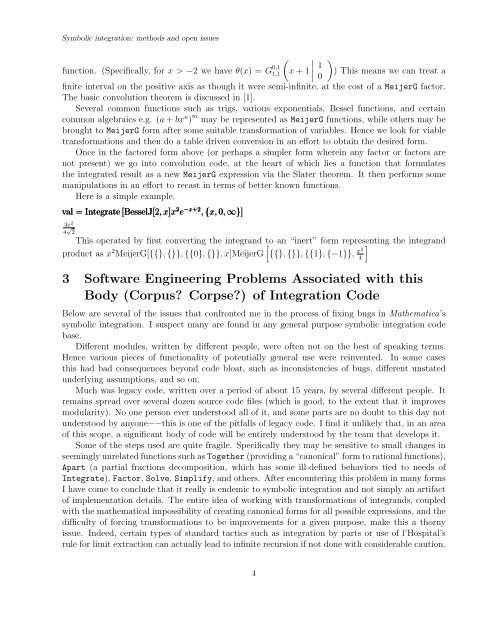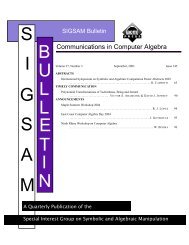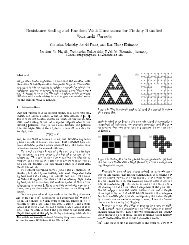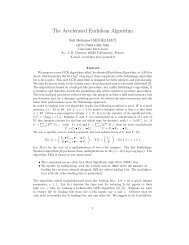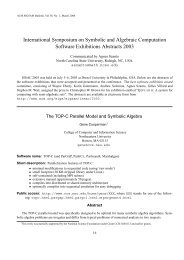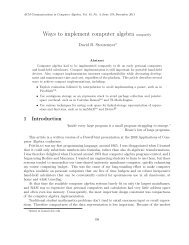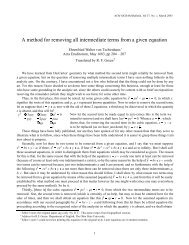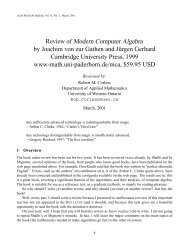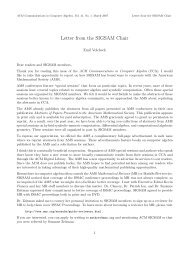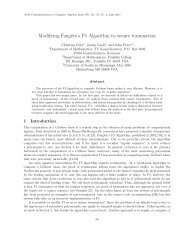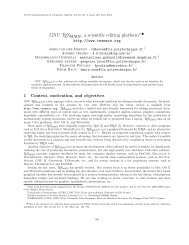Symbolic definite (and indefinite) integration: methods ... - SIGSAM
Symbolic definite (and indefinite) integration: methods ... - SIGSAM
Symbolic definite (and indefinite) integration: methods ... - SIGSAM
Create successful ePaper yourself
Turn your PDF publications into a flip-book with our unique Google optimized e-Paper software.
<strong>Symbolic</strong> <strong>integration</strong>: <strong>methods</strong> <strong>and</strong> open issues<br />
(<br />
function. (Specifically, for x > −2 we have θ(x) = G 0,1<br />
1,1 x + 1<br />
∣ 1 )<br />
) This means we can treat a<br />
0<br />
finite interval on the positive axis as though it were semi-infinite, at the cost of a MeijerG factor.<br />
The basic convolution theorem is discussed in [1].<br />
Several common functions such as trigs, various exponentials, Bessel functions, <strong>and</strong> certain<br />
common algebraics e.g. (a + bx n ) m may be represented as MeijerG functions, while others may be<br />
brought to MeijerG form after some suitable transformation of variables. Hence we look for viable<br />
transformations <strong>and</strong> then do a table driven conversion in an effort to obtain the desired form.<br />
Once in the factored form above (or perhaps a simpler form wherein any factor or factors are<br />
not present) we go into convolution code, at the heart of which lies a function that formulates<br />
the integrated result as a new MeijerG expression via the Slater theorem. It then performs some<br />
manipulations in an effort to recast in terms of better known functions.<br />
Here is a simple example.<br />
val = Integrate [BesselJ[2, x]x 2 e −x+2 , {x, 0, ∞}]<br />
3e 2<br />
4 √ 2<br />
This operated by first converting the integr<strong>and</strong> [ to an “inert” form representing ] the integr<strong>and</strong><br />
product as x 2 MeijerG[{{}, {}}, {{0}, {}}, x]MeijerG {{}, {}}, {{1}, {−1}}, x2<br />
4<br />
3 Software Engineering Problems Associated with this<br />
Body (Corpus? Corpse?) of Integration Code<br />
Below are several of the issues that confronted me in the process of fixing bugs in Mathematica’s<br />
symbolic <strong>integration</strong>. I suspect many are found in any general purpose symbolic <strong>integration</strong> code<br />
base.<br />
Different modules, written by different people, were often not on the best of speaking terms.<br />
Hence various pieces of functionality of potentially general use were reinvented. In some cases<br />
this had bad consequences beyond code bloat, such as inconsistencies of bugs, different unstated<br />
underlying assumptions, <strong>and</strong> so on.<br />
Much was legacy code, written over a period of about 15 years, by several different people. It<br />
remains spread over several dozen source code files (which is good, to the extent that it improves<br />
modularity). No one person ever understood all of it, <strong>and</strong> some parts are no doubt to this day not<br />
understood by anyone−−this is one of the pitfalls of legacy code. I find it unlikely that, in an area<br />
of this scope, a significant body of code will be entirely understood by the team that develops it.<br />
Some of the steps used are quite fragile. Specifically they may be sensitive to small changes in<br />
seemingly unrelated functions such as Together (providing a “canonical” form to rational functions),<br />
Apart (a partial fractions decomposition, which has some ill-defined behaviors tied to needs of<br />
Integrate), Factor, Solve, Simplify, <strong>and</strong> others. After encountering this problem in many forms<br />
I have come to conclude that it really is endemic to symbolic <strong>integration</strong> <strong>and</strong> not simply an artifact<br />
of implementation details. The entire idea of working with transformations of integr<strong>and</strong>s, coupled<br />
with the mathematical impossibility of creating canonical forms for all possible expressions, <strong>and</strong> the<br />
difficulty of forcing transformations to be improvements for a given purpose, make this a thorny<br />
issue. Indeed, certain types of st<strong>and</strong>ard tactics such as <strong>integration</strong> by parts or use of l’Hospital’s<br />
rule for limit extraction can actually lead to infinite recursion if not done with considerable caution.<br />
4


